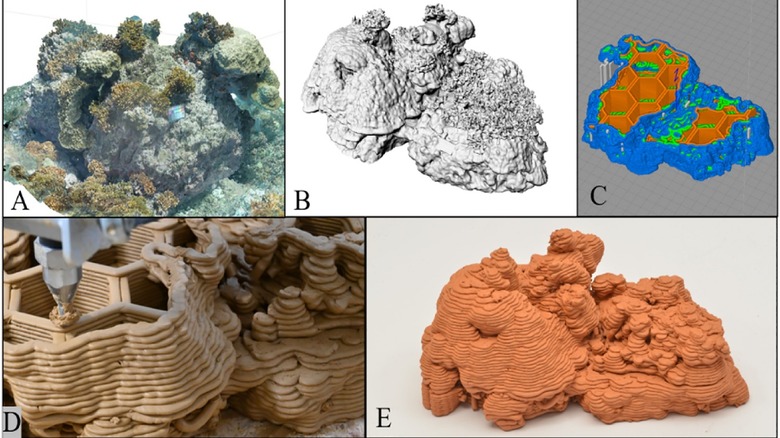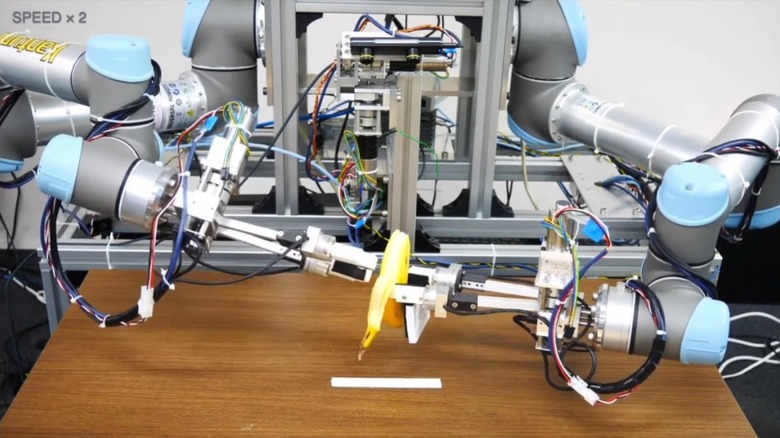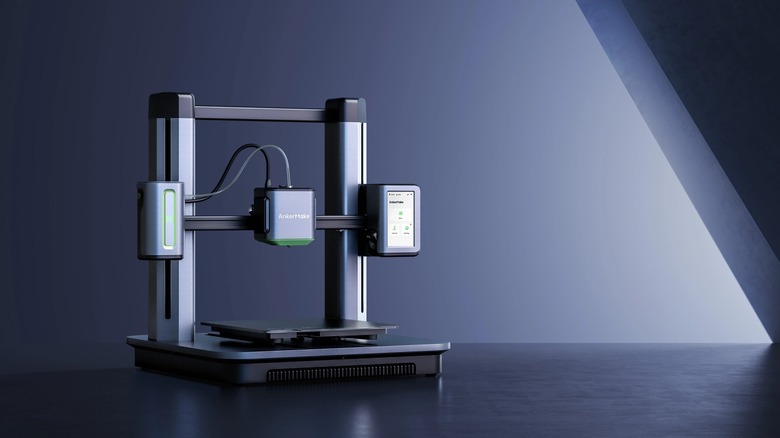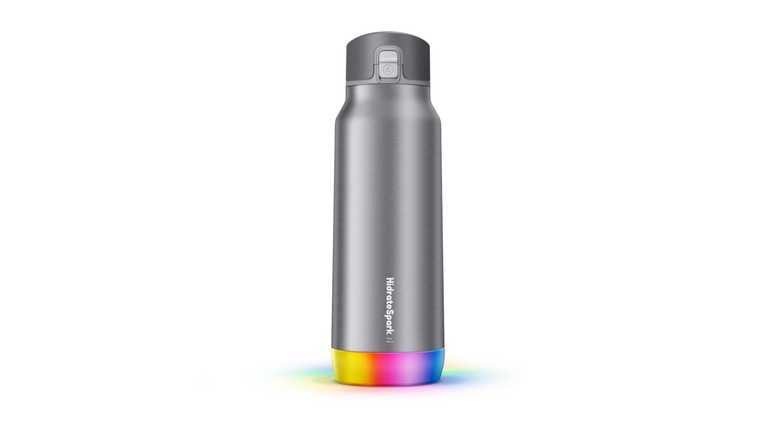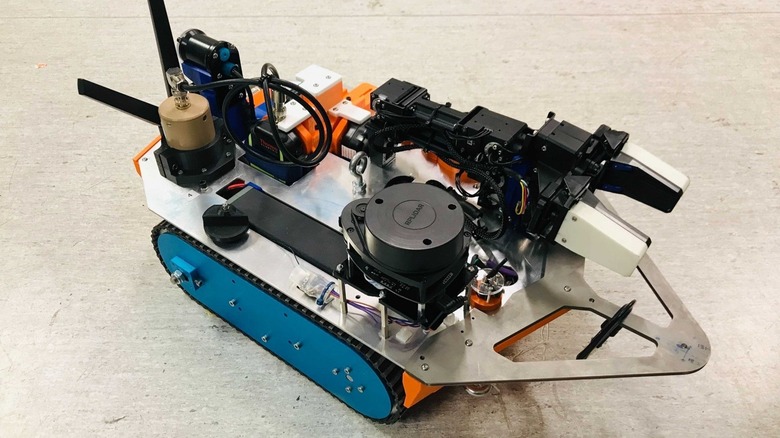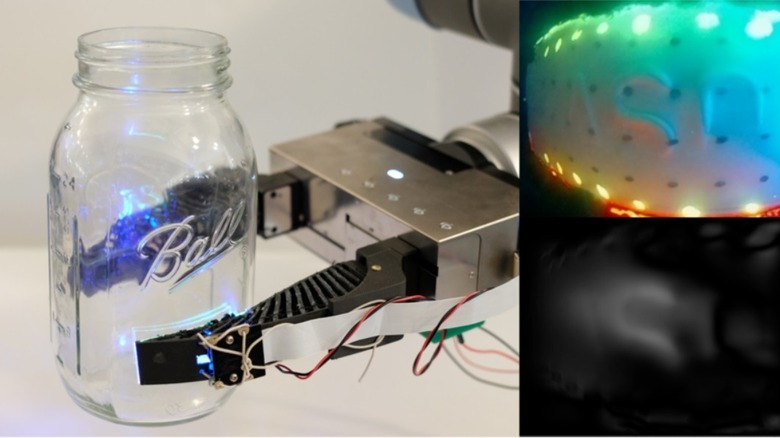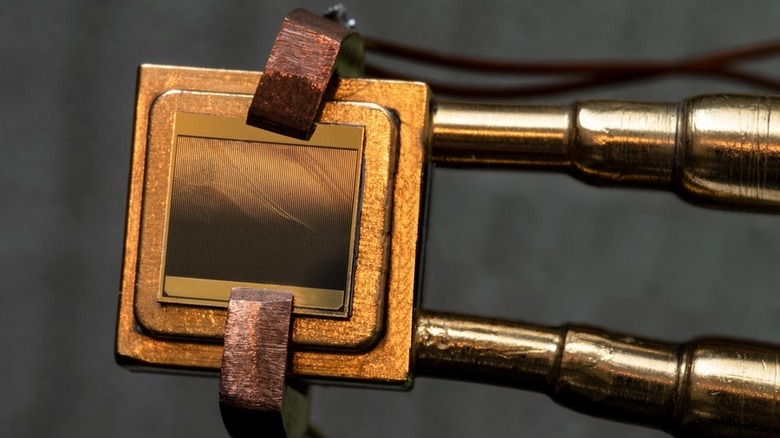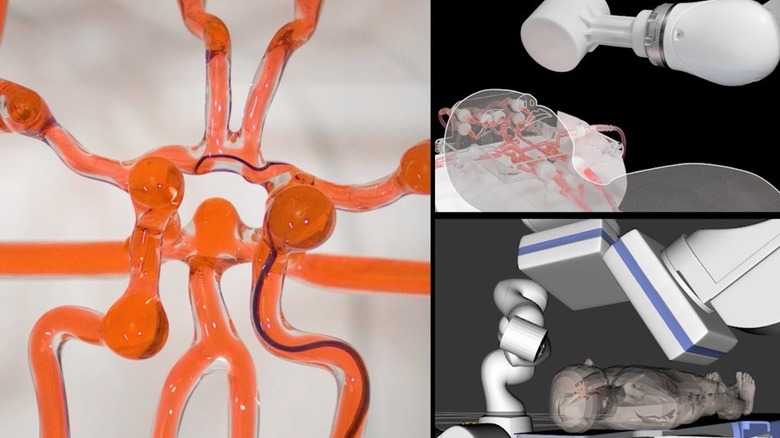The 12 Best Tech Inventions Of April 2022
From Nikola Tesla to Alexander Graham Bell and George Washington Carver, some of our favorite historical figures are inventors. The love of invention also bleeds into our stories, resulting in characters like Doc Brown, Wayne Szalinski, and Tony Stark. Inventors participate in and build upon scientific advances, putting new knowledge to practical use.
While some inventions don't stand the test of time, leaving only a blip on our everyday lives, even if they remain in our hearts and minds — we're looking at you Segway — others radically change the way we live and interact with the world.
Whether or not any particular recent invention is destined to be a flash in the pan or become a long-lasting part of our society remains to be seen. What we do know is that new inventions are making their way into our hands all of the time, and we want you to know about them. Here are the twelve coolest inventions to emerge from the minds of engineers and scientists in April 2022.
Coral reef printers
Coral reefs are a critical part of ocean ecosystems and they're suffering from the effects of human activities including global climate change. Reefs account for only 1% of the Earth's total surface but they sustain the highest level of marine diversity in the world (via How Stuff Works). If our reef systems fail, it will have a staggering impact not just on ocean ecosystems, but also on people all over the world who depend on them.
Consequently, conservationists are hard at work coming up with new and improved ways to sustain and restore remaining reef systems. A new paper published in the journal Science of the Total Environment reveals how conservationists are using 3D printers to construct customized artificial reefs.
As explained in the paper, the process begins with scanning the existing reef to identify its core characteristics and replicate them as closely as possible. Then, using a custom printer built in partnership with the Technion Institute of Technology, the reef is laid out.
Instead of the plastic filament commonly used in commercial 3D printers, the reef printer uses terracotta clay because it is porous and favored by coralline algae. Moreover, the printed reefs can be made modular and stacked, such that vast portions of coral reefs could be rebuilt while maintaining the structural variety seen in nature.
Banana-peeling robot
Robots are pretty good at discrete, repeatable tasks. That's why we use them in factory settings where they're only usually only called upon to the do the one thing they were specifically made for. More complex tasks, however, are typically reserved for humans. At least that was the case before engineers from the Intelligent Systems and Informatics Laboratory at the University of Tokyo built their new banana-peeling robot.
Peeling a banana is such a simple task that even a monkey could — and often does — do it. For robots, peeling a banana is a shockingly difficult task. We're not asking them to punch parts from sheets of metal or move solid objects from one place to another. Peeling a banana requires finesse.
Peeling a banana also requires spatial awareness. Unlike the parts of a car, for instance, bananas come in all different sizes and shapes. That means the robot can't simply repeat the same set of motions over and over. Instead, it has to know where the banana is, what part it needs to grasp, and how to move its robotic hands.
Scientists used AI deep learning to mimic the movements of human hands completing the same task. Even with the leading edge of machine learning, it's still only successful a little more than half the time. In fairness to the robot, we've messed up simpler tasks.
Anker 3D printer
A cursory look at Anker's website will reveal that the brand's primarily focused on charging solutions from wireless chargers to portable charging blocks. Now, Anker is moving into a new area of engineering with the announcement of its first 3D printer, the AnkerMake M5.
3D printers aren't exactly breaking news, but the AnkerMake comes with a slate of impressive features poised to make the device a player among existing printers. If you've ever started a big print and then walked away, you've probably experienced the dismay of checking on your print only to find that it's come loose from the build plate or lost its sync and now you're spitting filament all over the place. Not only have you wasted time, but you've also burned into your wallet, melting filament into an impressively recreated synthetic tumbleweed.
Anker aims to get around this problem with an AI-enabled camera that keeps an eye on your prints, so you don't have to. Using a companion app, you can check in on your print at any time, or it will send you an alert if something goes wrong.
According to the Kickstarter campaign, this printer is also at least five times faster than competitors, pumping out large prints in a fraction of the time. If you've been waiting to get a printer until they became easier to use, this might be the moment.
OneXPlayer Mini handheld PC gaming
Handheld gaming is undergoing something of a revival with the popularity of the Nintendo Switch, Analogue Pocket, and similar retro gaming devices. The biggest limitation of those systems is the quality and selection of games you're able to play. That's where the OneXPlayer Mini comes in. It takes the power of a gaming computer and puts it in the palm of your hand.
Building on the popularity of the Steam Deck, OneXPlayer is hoping to capture consumers who are currently waiting for Steam Deck to become available again. The major downside is price — the OneXPlayer can be twice the cost of a Steam Deck, depending on which version you choose.
In exchange for that extra cost, you'll get your hands on a pretty impressive gaming computer jammed into a handheld shell. It comes standard with Windows pre-installed and is essentially a shrunken gaming laptop.
If you don't have the patience to wait for the Steam Deck to re-emerge or if you just prefer Windows over Linus, and you have the disposable income, the OneXPlayer Mini could be the solution to your handheld PC gaming needs.
Apple's smart water bottle
From watches and phones to household appliances, everything is getting smarter. Now, thanks to Apple, that's also true of your water bottle.
The HidrateSpark Pro Smart Water Bottle — a mouthful, we know — takes all the guesswork out of tracking your water intake. The vacuum-insulated exterior should keep your liquids cold for up to a full day and it has a host of other neat features.
Apple's smart water bottle integrates with your Apple Watch and Apple Health. It takes into account your daily steps and exercise to calculate how much water you need (per Apple). The LED puck at the bottom of the bottle lights up to remind you when it's time for a drink and tracks how many ounces or millimeters of water you drink throughout the day, using BlueTooth. You can also get a slightly less expensive version, without the insulation, in the form of the HidrateSpark Pro Tritan Plastic Sea Glass.
If you've ever wanted a fancy way to micromanage your basic survival tasks, the HidrateSpark Pro Water Bottle can't be beat.
A nuclear inspection robot
Cleanup efforts following the Chernobyl power plant disaster famously utilized lunar rovers like the Lunokhod 1 (per National Space Centre), and other robots, to navigate the irradiated terrain, with variable success. Lunar rovers were chosen specifically because they are designed to withstand the radiation present on the lunar surface, as a result of having no atmosphere.
Now, a new nuclear inspection robot called Lyra is getting in on the action. As explained by Tech Xplore, Lyra was sent through 140 meters of ductwork in Dounreay's nuclear facilities in Scotland. Lyra is equipped with five radiation detectors, two cameras, lights, a robotic arm, and a LiDAR system for mapping, (per Technology).
The full suite of instruments allowed Lyra to create a 3D video map of the explored area. Using the radiation sensors, the video Lyra returned included readings of radiation hotspots overlayed on top of the images.
Robots like Lyra could allow for more detailed mapping of radiation risks, reducing the need for humans to become exposed as we deal with nuclear incidents like those at Chernobyl or Fukushima, in addition to its role at Dounreay.
An AI that judges your face
Facial recognition software isn't new, but it is gaining new abilities. You likely have some version of it on your phone right now. We count on those programs to recognize us and grant access to our technology when we need it. We also count on them not to judge us for our appearance, even on our worst days. In the future, however, all of that could change because of a new advancement in facial recognition.
Researchers taught an AI not only to recognize facial features, but to make snap judgements about a person's appearance. While being judged by a machine might hurt, it has important implications about the ways humans judge one another.
According to a research paper published in the Proceedings of the National Academy of Sciences, the first impressions we form upon meeting a new person influence decisions we make about them, including decisions about hiring and sentencing.
Researchers used machine learning to train an algorithm to make judgements based on photographs of faces which closely mirrored the judgements we make about ourselves and others. It's unclear what factors the algorithm used to make its judgments, (per Tech Xplore), but scientists think the data can still teach us how our appearance impacts the way we engage with the world.
If an AI judging you isn't unsettling enough, it could also be put to nefarious use, by modifying or curating pictures such that a person could present a particular visage to the world.
A robotic gripper with a sense of touch
As interactions between humans and robots become more common, it will become increasingly important that robots have a better sense of the environment around them. The last thing we want is a robot harming someone or breaking something because they don't know their own strength.
Scientists and engineers from MIT developed a new robotic system that uses Fin Ray grippers imbued with a sense of touch. As explained in a paper uploaded to Arxiv, Fin Ray grippers — which are modeled after fish fins — are useful for their ability to conform to the surface of an object. Rather than bend away from a surface, they curl inward to wrap around it.
Scientists achieved a sense of touch through an array of cameras embedded inside the grippers that watch for the way the fingers deform when in contact with a grasped object. By acutely measuring the way the gripper's shape changes, they can determine what it's holding in fine detail.
In tests, they were able to determine the letters on the surface of a glass jar as well as individual seeds ono a plastic strawberry. Incorporating this level of feedback could improve the performance of robots in situations when they are interfacing with people, making them safer and more effective.
Highly efficient heat engine
While steam-powered jetpacks and skies filled with airships never manifested, at least in any lasting way, we are still living in a steam-powered world. Most of the world's energy is generated using steam. Whether you're burning fossil fuels like coal or transforming nuclear radiation into electricity, it all takes a translational step through steam. The heat generated from those sources is used to boil water, generating steam which turns a turbine. That mechanical energy is ultimately what ends up flowing through the wires in your house. Now, thanks to a new heat engine from engineers at MIT, the age of steampunk may be over at last.
The new engine works using thermophotovoltaic (TPV) cells, which is really just a fancy way of saying it converts photons from heat directly into electricity. Moreover, it has no moving parts, which means it requires less maintenance than conventional turbines, (per Freethink).
While TPV engines have existed for some time, what makes this one special is its efficiency. It converts heat to electricity with 40% efficiency, making it more efficient than steam turbines which typically run at about 35%, (per MIT). According to researchers at MIT, this technology could lead to a decarbonized grid in the future.
Joystick controlled robotic surgeon
Endovascular operations for treating stroke or aneurysms require specialized training in which it takes years to become proficient (per EurkaAlert!). Consequently, only a small portion of doctors are able to complete them and they tend to be located at large medical centers in urban areas, (per MIT).
When a patient is experiencing a stroke or aneurysm, there is a "golden hour" during which they can be treated without lasting consequences. That's all fine and good if you happen to be located within a few minutes of a major medical center, but for patients in outlying areas without access to specially trained surgeons, that could mean the difference between recovering or not.
With that in mind, engineers at MIT have developed a telerobotic surgical system using a modified joystick that surgeons can use to perform operations remotely. According to a paper published in the journal Science Robotics, the system uses a flexible magnetized guidewire to navigate through blood vessels and reach the location of a clot to retrieve it or break it up.
If these systems were set up at hospitals around the country and the world, they could be operated remotely by trained surgeons in other cities, reducing the response time as well as rates of fatality and long-term disability.
Reprintable paper
Paper is generally seen as a greener material than plastic, largely because plastic is seen as artificial while paper feels more natural. Certainly, paper is more easily recycled but it comes with its own environmental costs which include cutting down trees, processing, and transportation, (via BBC).
Reducing our use of plastics is one way to minimize our impact on the environment, but we also need better ways to reduce paper usage and reuse it when possible. Reusing paper can be difficult, particularly if you've already written or printed something on it. There's little you can do aside from fold it into a paper airplane or chuck it in the recycling bin. Now, according to a paper published in the journal Advanced Materials, reusing your paper might get a lot easier.
Scientists from the Nanyang Technological University in Singapore have developed a new class of paper made from pollen instead of wood pulp. Pollen may be a greener material in and of itself, because it's already produced en masse, (via Science Daily), but this paper can also be readily used again.
Researchers put their pollen paper through a process that makes it non-allergenic and then printed on it using a standard laser printer. Treating it with an alkaline solution removed all of the printed material without damaging the paper, allowing it to be used again. In tests, they were able to reuse their paper at least eight times, making it the ultimate in recyclable paper.
VR system that moves your body for you
There's nothing better than virtual reality for total immersion, but it's still lacking a tactile element that would really help the technology level up. According to a recent paper, researchers at the University of Chicago have developed a virtual and augmented reality system which moves the user's body for them, at least some of the time.
Pads positioned on the neck muscles use electrical muscle stimulation to take control of a player's body and move it. In a fire safety demonstration, the technology was used to guide a player's eye-line toward the location of a fire extinguisher or live fire. Additional demonstrations moved a player's head in response to a punch from a virtual boxing opponent.
Importantly, the system senses what the user is doing in real-time and only initiates an involuntary movement when the muscles aren't otherwise activated. So, there's no risk of injury as a result of a triggered motion, even if you're being punched in VR.
Researchers believe this could change the way VR and AR experiences are developed by removing the need to add visual cues guiding a player.

